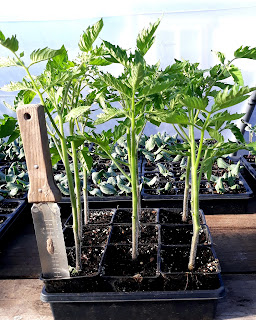Growing tomatoes in the San Francisco Bay Area
Some things I think are true, most of the time.
1. The soil is extremely important, and often neglected. If you are growing in containers, using the best soil money can buy is advised. Soil aeration is often neglected. There are two ways to starve your tomato roots of oxygen. First, if your soil is compacted, there won't be enough good air spaces for oxygen to diffuse into the roots. Second, if you over water (leaving soil waterlogged) you will fill up the air spaces and starve the roots of oxygen.
2. Don't over-crowd. One plant per 10+ gallon container is best. If you put more plants in a container they will likely just suppress each other. Over-crowding early in the season also leads to disease. If you are planting in the ground, you want to give your plants plenty of space. 3 feet clearance from neighbors is good. But if you plant in a row, you can plant as close as 18 inches, as long as you have wide rows for the plants to spread into. In the field, we have our rows 6 feet apart.
3. Don't plant too early. This week's cool, rainy weather is a reminder to not plant too early. We are not planting our field until there are no more rain showers in the forecast. All of our transplants are still in the greenhouse. Rain and cold gives fungal and bacterial diseases a very good environment to infect plants to the level where they can not fight them off well.
4. Trim the lower leaves off your plant before you transplant them (see photo). This reduces the amount of disease your plants will get through soil to leaf transfer. Although there are a number of people who might tell you to plant the transplants shown up to the leaves, I will not. We plant the transplants so that an inch of the stem is covered. We want a good distance to remain between the soil and the leaves. Again, for limiting disease access to plants.
5. Water thoroughly, early in the day. If the soil surface is still wet from the previous thorough watering, skip the watering. Watering later in the day promotes longer stretches of wet leaves and disease. However, on hot days you may need to water multiple times. Particularly if you are growing in containers.
6. Six hours of good sun is a minimum. Over-shaded plants will get big, but won't produce fruit. Put cherry tomatoes into places with marginal sun. They do better in more shaded conditions than larger fruited varieties.
7. Windy sites are terrible for tomatoes. If you are in a generally windy area you will want to plant your tomatoes in the most protected area you have.
8. For larger tomatoes that are growing in the ground, water well until the first fruits start to ripen, and then back off on the water. Plants with deep roots will produce sweeter and firmer fruits if they are allowed to dry down some. Watering heavily while fruits are ripening can produce mealy and watery fruits.



Comments
Post a Comment